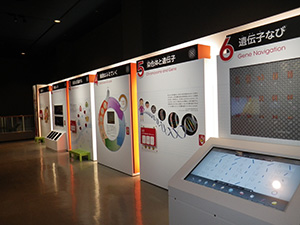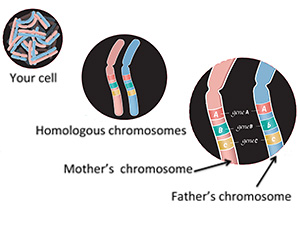Nagoya City Science Museum
TOP > Exhibition Guide > Keyword Search > Starting with "C" > Chromosomes > Cell Biology Lab
Cell Biology Lab

Purpose of Exhibition
This exhibit is for learning about cells, which are the basic unit of organisms, and the genes that human cells have. Through the observation of various cells and the movies, please make an image the cells that act dynamically, beyond the cell diagrams found in your textbooks. This exhibit also takes up the cell cycle, as basic knowledge for understanding stem cells and iPS cells. The number of human genes is estimated to be from 20,000 to 30,000, but to see which genes are where in an actual cell, we have the "Gene Navigation" corner, where you can search for typical human genes.


Additional Knowledge
Our human bodies are said to be made up of about 60 trillion cells. Each of those cells has a nucleus and all the genetic information for producing one human being is contained in the nucleus of each one of those cells. The nucleus is usually round, but when the cell divides, in order to distribute the genetic information correctly into the two new cells, the round form disappears and the nucleus takes the form of rod-shaped "Chromosomes". For a human being, these chromosomes comprise the 22 autosomal chromosomes numbered in order from 1 to 22 and the sex chromosomes, X and Y. Men have two sets of 22 autosomal chromosomes and an X chromosome and a Y chromosome for a total of 46. Women have the two sets of autosomal chromosomes and two X chromosomes for a total of 46. We wrote this as two sets, but one set was received in the egg from our mother and the other set in the sperm from our father. These join together to form the fertilized egg. Cell division is repeated, copying the genetic information each time, and the human being grows.
Now you might think that this means that siblings born from the same mother and father will have the exact same chromosomes. Actually, there is an interesting mechanism that affects this. First, the cell division that produces the eggs and sperm is called "meiosis". The cells divide differently in meiosis from "Somatic Cell Division" (mitosis). One set of chromosomes each is received from the mother and from the father, but the problem is the combination of chromosomes in each set. It is not that the 23 chromosomes all work together. Each chromosome, if you go to the bases, was received from your parents’ parents, in other words your grandparents. If we think about the combinations of 23 chromosomes, there are 2 raised to the 23rd power combinations, that is about 8.4 million different combinations. Furthermore, in meiosis, the chromosomes with the same number come in contact with each other and mix (recombine). In other words, within one chromosome, the portions received from a grandfather or grandmother mix to form a chromosome with a new combination and this is transmitted to your children. Therefore, the combinations of genes are infinite and each person has different genes. Each of us is, like the song says, "The only one".
The method of expressing gene addresses on chromosomes is common around the world. When chromosomes are dyed with a certain dyeing technique, they always dye with the same striped pattern. This pattern and the neck section (centromeres) are the clues for determining the addresses. This is how we can express where on which number chromosome a certain gene is.
Article by Chieko Ozaka,curator
